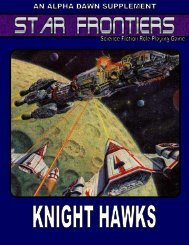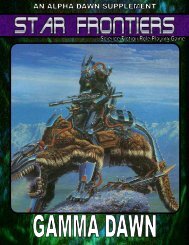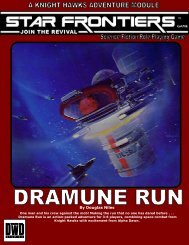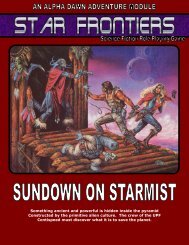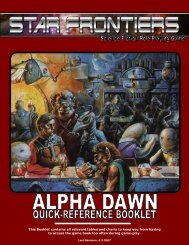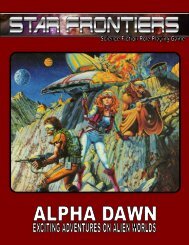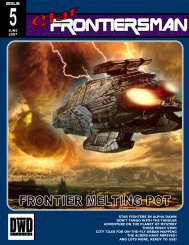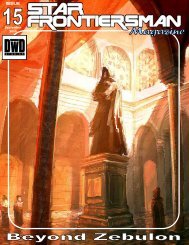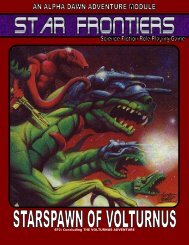Alpha Dawn - Star Frontiersman
Alpha Dawn - Star Frontiersman
Alpha Dawn - Star Frontiersman
You also want an ePaper? Increase the reach of your titles
YUMPU automatically turns print PDFs into web optimized ePapers that Google loves.
Creating Creatures<br />
When creating creatures for STAR FRONTIERS<br />
adventures, the referee should give each creature a<br />
purpose in the adventure, and should have a reason<br />
for designing the creature in the form he gives it.<br />
Referees may find a basic reference book on zoology or<br />
biology a helpful source for making believable<br />
creatures.<br />
A step-by-step procedure is given below to help the<br />
referee create new creatures.<br />
1<br />
What is the Creature's Purpose?<br />
The referee should decide why the creature is<br />
needed in the adventure. Is it to fight the player<br />
characters? To mislead them? To be a nuisance to<br />
them? To give them important information? To give<br />
them a mystery to be solved? Or to set the stage for<br />
future encounters? Knowing a creature's purpose will<br />
make it easier for the referee to fill in the details about<br />
a creature.<br />
When deciding on a purpose for a creature, the referee<br />
should consider these other questions:<br />
• Where does the creature live, and where is its lair?<br />
• What life form is the creature? (bird, reptile, worm,<br />
etc.)<br />
• How does the creature live? Does it have any special<br />
habits? (living alone, moving only at night, hanging<br />
upside down, shrieking at strangers, etc.)<br />
• Does the creature have any special weaknesses?<br />
(poor vision, slow movement, powerful natural<br />
enemies, etc.)<br />
2 3<br />
What Type of Creature Is It?<br />
A creature's type is determined by its size, what<br />
it eats and how it obtains its food. Eating habits<br />
can divide animals into three basic groups:<br />
herbivores (plant eaters), carnivores (meat eaters) and<br />
omnivores (plant and meat eaters). After placing the<br />
animal in one of these groups, the referee should<br />
decide what specific foods it eats and how it gets this<br />
food. For example, a creature might eat small rodents<br />
that it digs out of the ground with sharp claws.<br />
• HERBIVORES are normally timid, but will protect<br />
themselves if they are attacked. They usually are<br />
adapted to avoid or repel attackers. Some, like bulls,<br />
may even counter attack. Herbivores obtain their food<br />
by grazing, harvesting, digging, filter-feeding or<br />
growing their own. Examples: rabbits, squirrels,<br />
small fish, sloths, sparrows, goats, deer, kangaroos,<br />
horses, cattle, camels, tortoises, moths, elephants,<br />
hippopotamuses and brontosaurs.<br />
• CARNIVORES may eat any type of meat, but usually<br />
prefer only one kind, such as fish or insects. They<br />
almost always have effective natural weapons, such<br />
as claws, fangs or poisons. These natural weapons<br />
make them more dangerous than most herbivores.<br />
They may catch their food by hunting, pouncing, or<br />
luring prey into traps. Examples: frogs, piranhas,<br />
shrews, owls, rattlesnakes, wolves, seals, tigers,<br />
sharks, crocodiles, tyrannosaurs, squids, spiders and<br />
sperm whales.<br />
• OMNIVORES may or may not be dangerous, but<br />
they usually are curious. Many have natural weapons,<br />
but these are often less effective than the carnivores'<br />
and are used mostly for catching small prey and<br />
discouraging predators. Omnivores usually obtain<br />
their food by foraging, hunting and scavenging. Most<br />
intelligent life forms are omnivores. Examples: ants,<br />
armadillos, porcupines, rats, monkeys, crows, turtles,<br />
pigs, chimpanzees, ostriches, bears and whales.<br />
How large is the Creature?<br />
A creature's size effects how dangerous the<br />
creature is. For game purposes. creatures are<br />
divided into five different size groups -- tiny,<br />
89



